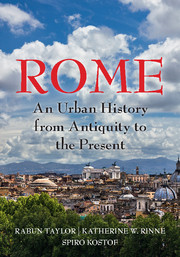Book contents
- Frontmatter
- Dedication
- Epigraph
- Contents
- List of Illustrations
- Acknowledgments
- Map
- INTRODUCTION
- 1 A BEND IN THE RIVER
- 2 A STORYBOOK BEGINNING
- 3 IDEOLOGICAL CROSSFIRE
- 4 BIG MEN ON THE CAMPUS
- 5 RES PUBLICA RESTITUTA
- 6 MEMORIALS IN MOTION: SPECTACLE IN THE CITY
- 7 THE CONCRETE STYLE
- 8 REMAKING ROME'S PUBLIC CORE: I
- 9 REMAKING ROME'S PUBLIC CORE: II
- 10 CRISIS AND CONTINUITY
- 11 RUS IN URBE: A GARDEN CITY
- 12 ADMINISTRATION, INFRASTRUCTURE, AND DISPOSAL OF THE DEAD
- 13 MAPPING, ZONING, AND SEQUESTRATION
- 14 TETRARCHIC AND CONSTANTINIAN ROME
- 15 TROPHIES AND TITULI: CHRISTIAN INFRASTRUCTURE BEFORE CONSTANTINE
- 16 WALLS MAKE CHRISTIANS: FROM FOURTH TO FIFTH CENTURY
- 17 A TALE OF TWO ROMES
- 18 THE ROME OF GOTHS AND BYZANTINES
- 19 CHRISTIAN FOUNDATIONS
- 20 FROM DOMUS LATERANI TO ROMANUM PALATIUM
- 21 THE LEONINE CITY: ST. PETER'S AND THE BORGO
- 22 VIA PAPALIS, THE CHRISTIAN DECUMANUS
- 23 THE URBAN THEATERS OF IMPERIUM AND SPQR
- 24 HOUSING DAILY LIFE
- 25 CHAOS IN THE FORTIFIED CITY
- 26 THE TIBER RIVER
- 27 HUMANIST ROME, ABSOLUTIST ROME (1420–1527)
- 28 PLANNING COUNTER REFORMATION ROME
- 29 PROCESSIONS AND POPULATIONS
- 30 MAGNIFICENT PALACES AND RHETORICAL CHURCHES
- 31 NEOCLASSICAL ROME
- 32 PICTURING ROME
- 33 REVOLUTION AND RISORGIMENTO
- 34 ITALIAN NATIONALISM AND ROMANITÀ
- 35 A CITY TURNED INSIDE OUT
- Glossary of Persons, Places, and Terms
- Works Cited
- Index
6 - MEMORIALS IN MOTION: SPECTACLE IN THE CITY
Published online by Cambridge University Press: 05 July 2016
- Frontmatter
- Dedication
- Epigraph
- Contents
- List of Illustrations
- Acknowledgments
- Map
- INTRODUCTION
- 1 A BEND IN THE RIVER
- 2 A STORYBOOK BEGINNING
- 3 IDEOLOGICAL CROSSFIRE
- 4 BIG MEN ON THE CAMPUS
- 5 RES PUBLICA RESTITUTA
- 6 MEMORIALS IN MOTION: SPECTACLE IN THE CITY
- 7 THE CONCRETE STYLE
- 8 REMAKING ROME'S PUBLIC CORE: I
- 9 REMAKING ROME'S PUBLIC CORE: II
- 10 CRISIS AND CONTINUITY
- 11 RUS IN URBE: A GARDEN CITY
- 12 ADMINISTRATION, INFRASTRUCTURE, AND DISPOSAL OF THE DEAD
- 13 MAPPING, ZONING, AND SEQUESTRATION
- 14 TETRARCHIC AND CONSTANTINIAN ROME
- 15 TROPHIES AND TITULI: CHRISTIAN INFRASTRUCTURE BEFORE CONSTANTINE
- 16 WALLS MAKE CHRISTIANS: FROM FOURTH TO FIFTH CENTURY
- 17 A TALE OF TWO ROMES
- 18 THE ROME OF GOTHS AND BYZANTINES
- 19 CHRISTIAN FOUNDATIONS
- 20 FROM DOMUS LATERANI TO ROMANUM PALATIUM
- 21 THE LEONINE CITY: ST. PETER'S AND THE BORGO
- 22 VIA PAPALIS, THE CHRISTIAN DECUMANUS
- 23 THE URBAN THEATERS OF IMPERIUM AND SPQR
- 24 HOUSING DAILY LIFE
- 25 CHAOS IN THE FORTIFIED CITY
- 26 THE TIBER RIVER
- 27 HUMANIST ROME, ABSOLUTIST ROME (1420–1527)
- 28 PLANNING COUNTER REFORMATION ROME
- 29 PROCESSIONS AND POPULATIONS
- 30 MAGNIFICENT PALACES AND RHETORICAL CHURCHES
- 31 NEOCLASSICAL ROME
- 32 PICTURING ROME
- 33 REVOLUTION AND RISORGIMENTO
- 34 ITALIAN NATIONALISM AND ROMANITÀ
- 35 A CITY TURNED INSIDE OUT
- Glossary of Persons, Places, and Terms
- Works Cited
- Index
Summary
IT HAS BEEN SAID THAT ANCIENT ROMAN CITY LIFE, FROM THE MOST ORDINARY human encounters to the grandest pageantry, was a perpetual spectacle. The powerful patronage system, ensuring that most free persons were in social debt to someone else, promoted the idea that one's own business was also the business of others. This system encouraged fierce competition for favor and resources, demanding social contact and mobility in numerous forms: traveling to greet, dine with, or bathe with one's patrons and fellow clients; providing bodyguards; running errands; conveying messages; soliciting votes; punishing criminals or slaves. Movement encouraged visibility. Nobody avoided the stage.
The physical setting pervaded everyday city life. To live in Rome was to perform against the backdrops of its fabric. Visible monuments of past glory were abundantly available to enrich the rhetoric of the moment. But fierce political competition guaranteed that present glory and its attendant monuments were only conferred with misgivings or downright resentment. Public figures felt and feared the seductive power of their rivals’ proprietary monuments. In 381 B.C.E., a trial of Marcus Manlius Capitolinus was moved out of sight of the Capitoline after he invoked his famous defense of that hill during the Gallic invasion by calling it to the visual attention of his audience. In 58, Clodius tried to neutralize the exiled Cicero by publicly destroying the orator's house on the Palatine and replacing it with a shrine to the goddess Libertas. This was not so much an erasure as an exorcism: the spirit of Liberty would chase out the demons of Cicero's perceived tyranny. Such was the power of the mind's eye; so vivid was the rhetoric of topography.
The earliest and most durable organized spectacles at Rome were religious processions accompanying sacrifices at urban or suburban sanctuaries on prescribed days (fasti) in the religious calendar. These followed specific routes designed, in effect, as progressive memorials to the local gods and heroes of antiquity. For example, the sacrifice of the Lupercalia festival took place at the Lupercal, a cave in the Palatine Hill where the wolf was said to have suckled Romulus and Remus. The route of the “procession,” really a festive dash of loincloth-clad priests striking willing young women with their ritual goatskins to ensure fertility, traced the path of Romulus’ original pomerium around the Palatine Hill.
- Type
- Chapter
- Information
- RomeAn Urban History from Antiquity to the Present, pp. 52 - 59Publisher: Cambridge University PressPrint publication year: 2016



